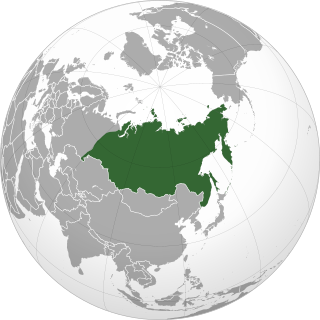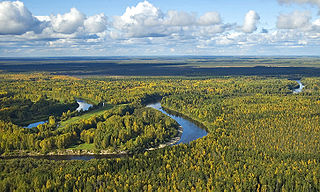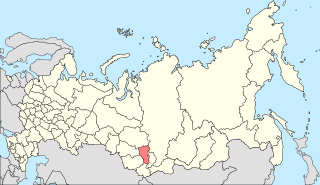
Siberia is an extensive geographical region comprising all of North Asia, from the Ural Mountains in the west to the Pacific Ocean in the east. It has formed a part of the sovereign territory of Russia and its predecessor states since the centuries-long conquest of Siberia, which began with the fall of the Khanate of Sibir in the late 16th century and concluded with the annexation of Chukotka in 1778. Siberia is vast and sparsely populated, covering an area of over 13.1 million square kilometres (5,100,000 sq mi), but home to roughly a quarter of Russia's population. Novosibirsk, Krasnoyarsk, and Omsk are the largest cities in the area.

Novosibirsk Oblast is a federal subject of Russia located in southwestern Siberia. Its administrative and economic center is the city of Novosibirsk. As of the 2021 Census, Novosibirsk Oblast had a population of 2,797,176.

Omsk Oblast is a federal subject of Russia, located in southwestern Siberia. The oblast has an area of 139,700 square kilometers (53,900 sq mi). Its population is 1,977,665 with the majority, 1.12 million, living in Omsk, the administrative center.

Kemerovo Oblast, also known as Kuzbass, after the Kuznetsk Basin, is a federal subject of Russia. Kemerovo is the administrative center and largest city of the oblast. Kemerovo Oblast is one of Russia's most urbanized regions, with over 70% of the population living in its nine principal cities. Its ethnic composition is predominantly Russian, but native Shors and Kalmak Siberian Tatars also live in the oblast, along with Ukrainians, Volga Tatars, and Chuvash. The population recorded during the 2021 Census was 2,600,923.

Tyumen Oblast is a federal subject of Russia. It is located in Western Siberia, and is administratively part of the Urals Federal District. The oblast has administrative jurisdiction over two autonomous okrugs: Khanty-Mansi Autonomous Okrug and Yamalo-Nenets Autonomous Okrug. Tyumen Oblast, including its autonomous okrugs, is the third-largest federal subject by area, and has a population of 3,395,755 (2010).

The West Siberian Plain is a large plain that occupies the western portion of Siberia, between the Ural Mountains in the west and the Yenisei River in the east, and the Altai Mountains on the southeast. Much of the plain is poorly drained and consists of some of the world's largest swamps and floodplains. Important cities include Chelyabinsk, Novosibirsk, Omsk, and Tomsk, as well as Surgut and Nizhnevartovsk.

Russia is divided into twelve economic regions — groups of federal subjects sharing the following characteristics:

Ural Economic Region is one of twelve economic regions of Russia. This prominent industrial region consists of the following subdivisions : Bashkortostan (Ufa), Chelyabinsk Oblast (Chelyabinsk), Kurgan Oblast (Kurgan), Orenburg Oblast (Orenburg), Perm Krai (Perm), Sverdlovsk Oblast (Yekaterinburg) and Udmurt Republic (Izhevsk). It is mostly located in the Central, and partly in the Southern and Northern parts of the Urals, but also includes parts of the East European and West Siberian Plains. Its extent is different from that of the Ural Federal District; Bashkortostan, Orenburg Oblast, Perm Krai and Udmurtia are in the Volga Federal District while the other three are in the Ural Federal District.

UTC+06:00 is an identifier for a time offset from UTC of +06:00. This time is used in:
Geographically, Siberia includes the Russian Urals, Siberian, and Far Eastern Federal Districts.

Guryevsky District is an administrative district (raion), one of the nineteen in Kemerovo Oblast, Russia. As a municipal division, it is incorporated as Guryevsky Municipal District. It is located in the west of the oblast and borders with Prokopyevsky, Belovsky, and Leninsk-Kuznetsky Districts of Kemerovo Oblast and with Altai Krai and Novosibirsk Oblast in the west. The area of the district is 2,180 square kilometers (840 sq mi). Its administrative center is the town of Guryevsk. Population: 10,617 (2010 Census); 12,057 ; 20,816 (1989 Soviet census).
Education in Siberia expanded greatly after the Trans-Siberian Railway was completed in the 19th century. While Siberia became part of Russia in the 17th century it was not until the 20th century under the Soviet Union that education was transformed which in turn brought Siberia to economic importance. This was aimed at uniting people under the Soviet. For example, the Irkutsk State Linguistic University served as "a conduit between Russia and these native people by teaching languages" during the communist era. Imperial Russia began uniting Siberia to Russia by founding Siberia's first university, Tomsk State University, in 1878.

Western Siberia or West Siberia is a region in North Asia. It is part of the wider region of Siberia that is mostly located in the Russian Federation, with a Southern part in Kazakhstan. It lies between the Ural region and the Yenisei River, which conventionally divides Siberia into two halves.

Russia, the largest country in the world by area, has international land borders with fourteen sovereign states as well as 2 narrow maritime boundaries with the United States and Japan. There are also two breakaway states bordering Russia, namely Abkhazia and South Ossetia. The country has an internationally recognized land border running 22,407 kilometres (13,923 mi) in total, and has the second-longest land border of any country in the world, after China. The borders of the Russian Federation were mostly drawn since 1956, and have remained the same after the dissolution of the Soviet Union. In 2014, Russia annexed Ukraine's Crimean peninsula in a move that remains internationally unrecognized.

South Central Siberia is a geographical region in North Asia, just north of the meeting point between Russia, China, Kazakhstan and Mongolia.

West Siberian Railway is a Rail operator of Russian Railways and part of the Great Trans-Siberian Railway crossing the Omsk, Novosibirsk, Kemerovo, Tomsk, and Altai regions of the Russian Federation as well as a portion of Kazakhstan.

Siberian Tatar is a Turkic language spoken by about 140,000 people in Western Siberia, Russia, primarily in the oblasts of Tyumen, Novosibirsk, Omsk but also in Tomsk and Kemerovo. According to Marcel Erdal, due to its particular characteristics, Siberian Tatar can be considered as a bridge to Siberian Turkic languages.

Tomsk Governorate was an administrative-territorial unit (guberniya) of the Russian Empire, the Russian Republic, and the Russian SFSR, which existed from 1804 to 1925 as part of Siberian Governorate-General (1804–1822) and West Siberian Governorate-General (1822–1882). Its capital was in Tomsk.
Novosibirsk Tuberculosis Research Institute (NTRI) is a Federal State Budgetary Institution of the Ministry of Health of the Russian Federation and it specializes in the research and treatment of tuberculosis. NTRI provides the organization of TB care to the population in the regions of the Siberian and Far Eastern Federal Districts of Russia.
Novosibirsk Research Institute of Hygiene is a research institute in Leninsky District of Novosibirsk, Russia. It was founded in 1930.

















